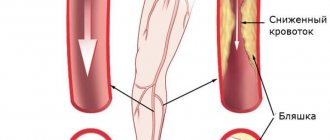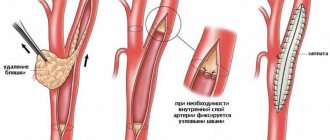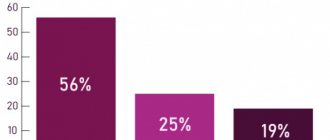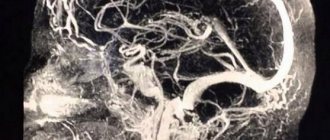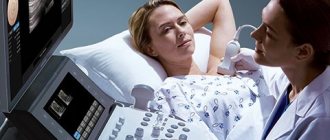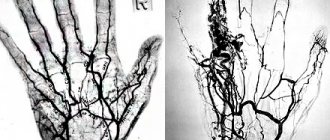Changed blood vessels in the legs and alarming symptoms are a reason to do CT angiography of the lower extremities
CT angiography of the lower extremities (CTA) is a non-invasive test that allows you to evaluate the vessels of the legs. This type of diagnosis is recommended by a phlebologist or vascular surgeon. Previously used catheter angiography is now practically not performed, as it is associated with high risks (pseudoaneurysm, arteriovenous fistulas). Modern CTA has advantages - the absence of serious complications, quick results, lower cost, and the ability to examine patients with pacemakers and implants. For better visualization of vascular structures and nearby soft tissues, an iodinated contrast agent is injected.
What does CT angiography of the lower extremities show?
Reconstruction of CT angiography of leg vessels
CT angiography can evaluate the entire arterial tree, from the aortic arch to the vessels of the toes, if indicated. CT angiography of the lower extremities demonstrates the arterial wall and its lumen, which makes the procedure indispensable in assessing atherosclerotic plaque or aneurysm morphology. Tomograms show changes in nearby tissues, and bone structures are well visualized. The results of CT angiography provide the vascular surgeon with complete information about the location of the obstruction, the severity of vascular diseases, and allow one to determine the appropriate strategy for surgical intervention. CT angiography of the lower extremities shows:
- systemic or regional arterial insufficiency due to atherosclerosis;
- Buerger's disease (thromboangiitis obliterans), vasospastic processes;
- trauma and its consequences (hematomas, blood clots, vascular intimal ruptures, their compression, occlusion, dissection, as well as aneurysm, pseudoaneurysm, arteriovenous fistula);
- inflammatory changes (vasculitis);
- condition after removal of the fibular graft (vascular assessment);
- non-traumatic thrombosis of a vessel or an installed stent;
- arterial embolism;
- tumor masses in the lumen of the vessel;
- congenital vascular anomalies and arteriovenous malformations;
- disorganized vessels, including feeding neoplasms;
- vein diseases
CT angiography of the arteries of the lower extremities is used to monitor the dynamics after open or percutaneous revascularization. The study is performed before plastic surgery if they plan to remove material for autotransplantation. Duplex scanning and MRI are preferred for assessing changes in postthrombophlebetic syndrome and vascular mass, but CT angiography also finds lesions in patients being evaluated for peripheral ischemia. Multidetector computed angiography has a larger coverage volume and ultra-high spatial resolution, and the speed of the diagnostic procedure allows for a reduction in the amount of injected contrast agent. CT is preferable to MRI for the evaluation of microangiopathies.
How to do CT angiography of the arteries of the lower extremities
To avoid blurring on tomograms, complete immobility is required during the diagnostic procedure.
The technician places the patient on the CT scanner table in a supine position, using pillows and straps to ensure immobility.
To obtain images of blood vessels, a catheter is inserted into a vein, through which a radiopharmaceutical is automatically delivered at certain intervals during the examination (diagnostics with bolus contrast). In some cases, especially in patients with fragile and small veins, the contrast agent is injected using a syringe. The diagnostic procedure is controlled remotely. In a CT scan, X-ray emitters and detectors rotate around a given area, recording the amount of radiation absorbed. Normal anatomical structures and pathologically altered tissues reflect different volumes, which is the basic principle of diagnosis. The obtained data is processed using a computer, and special programs restore a three-dimensional image of the area under study on the monitor.
MSCT (multispiral computed tomography) is a more advanced type of CT that allows you to adjust installation parameters for each patient individually. Images can be stored, printed or copied to any electronic storage medium.
Advantages
- Low radiation exposure (due to the use of latest generation equipment).
- The duration of the study is 20 minutes.
- Very high information content.
- Opportunity to conduct research any day of the week, from morning to evening.
- A modern device designed for patients of different sizes.
- Qualified doctors of the first and highest categories; candidates of sciences also work in medicine.
- The conclusion for each examination must be checked by the chief physician.
Preparation for angiography of the extremities
Eat a light snack 40 minutes before contrast injection to help avoid nausea and dizziness.
Preparation for CT angiography of the vessels of the lower extremities does not require any special measures; it is enough to choose comfortable clothes without metal parts, and remove all jewelry, hairpins, and glasses before the procedure. This measure will prevent the appearance of artifacts (blurs) on the film that affect the quality of tomograms.
It is better to sign up for diagnostics by phone or through the form on the website, taking with you all the results of previous examinations, a referral from a doctor and the result of a blood test for creatinine. At the Magnit diagnostic center in St. Petersburg, this testing can be completed for an additional fee immediately before performing CT angiography of the arteries of the lower extremities; in this case, you must arrive at the clinic 15 minutes earlier. The study is carried out using the express method.
48 hours before performing contrast, in agreement with the endocrinologist, it is necessary to stop taking Metformin (a hypoglycemic drug) and its analogues. During lactation, it is recommended to store milk for 2 subsequent feedings.
To reduce the manifestation of autonomic reactions to the administration of the radiopharmaceutical, you should have a light snack 40 minutes before the procedure.
Sign up for a test today
The cost of the examination includes angiography of the abdominal aorta and leg vessels. The price for MSCT contrast examination of the vessels of the lower extremities and abdominal aorta at the Novaya Hospital is 6,400 rubles. (including the cost of contrast). You can get a consultation or sign up for an examination in several ways:
- call a multi-channel number;
- through an online form on the official website (indicate your full name and phone number, and hospital managers will call you back);
- via an online form to radiologists working at the New Hospital.
The head of the X-ray department is Olga Viktorovna Kolmakova, a doctor of the highest qualification category.
Which is better: CT angiography of the lower extremities with or without contrast?
Contrast in CT angiography provides better visualization: on the left is the process of vessel catheterization, on the right is an angiogram with an arrow indicating the pathological zone
To obtain the most detailed images, contrast is necessary. There is no need to be afraid of administering contrast in the absence of contraindications; complications in the form of anaphylactic reactions are extremely rare. Doctors have a range of drugs in their arsenal to provide emergency medical care in urgent situations. The price of CT angiography of the lower extremities varies in different clinics; at the Magnit diagnostic center, the cost of diagnostics is affordable for most patients, as there is a flexible system of discounts.
Complications of angiography
Complications of CT angiography are quite rare.
To reduce the risk of developing adverse reactions, it is advisable for the patient to undergo a series of tests (CBC, BAM, coagulogram, creatinine, urea) before the examination. If there are deviations from the norm, preliminary treatment of concomitant pathologies will be necessary. Side effects after angiography may include: infection and suppuration of the wound through which the contrast was administered, bleeding, the appearance of edema or hematoma at the injection site. In rare cases, acute renal or liver failure develops when contrast is administered.
Indications and contraindications
CT angiography has its indications and contraindications
CT angiography of the lower extremities is justified if the results of other diagnostic methods cannot be interpreted unambiguously. The study can be performed if there are the following complaints:
- pain in the lower extremities;
- fatigue in the legs after minor physical activity;
- swelling in the ankle area;
- paresthesia in the feet and legs;
- cramps in the calf muscles (especially at night);
- changes in the skin (pattern wear, atrophy of hair follicles, dryness and flaking, the appearance of hyperpigmentation and areas of ulceration);
- visible deformation of blood vessels, compaction, etc.
With claudication, there is a possibility of occlusive diseases of the peripheral arteries, which are associated with the abdominal aorta (its bed is additionally assessed and an aneurysm is excluded).
During pregnancy and childhood, other examination methods are preferable, since X-ray radiation and contrast are contraindicated for this category of people. In this case, MRI and ultrasound of the lower extremities with Doppler (duplex scanning) are performed. For health reasons, it is possible to perform MSCT without enhancement. The administration of contrast is unacceptable to patients with a burdened allergic history (hypersensitivity reactions to iodine), chronic renal failure and hyperfunction of the thyroid gland.
Risks
Risks of CT angiography include:
- Exposure to ionizing radiation
- Allergy to contrast agent
- Damaging effects of contrast on the kidneys
CT scans result in much more radiation exposure than X-rays, and frequent procedures can increase the risk of developing cancer. But with the development of technology, the radiation dose from CT is decreasing.
- Most often, agents containing iodine are used to contrast CT scans. If a patient has a reaction to iodine, then the risk of developing a reaction to contrast is quite high
- If a patient with a reaction to iodine requires CT angiography, then it is possible to use antihistamines or steroids before the procedure.
- Given that iodine is excreted by the kidneys, it is recommended to take more fluids after contrast angiography to minimize the effect on the kidneys.
- Very rarely, contrast can cause a very dangerous reaction - anaphylactic shock. If a patient develops symptoms such as shortness of breath or weakness, he should immediately notify the x-ray technician.
Photo of CT angiography of the lower extremities
The radiologist interprets the results and issues a conclusion. At the Magnit diagnostic center in St. Petersburg, our doctors will answer any questions, and CT angiography of the arteries of the lower extremities often plays a leading role in establishing the final diagnosis. We have selected several photo tomograms with characteristic pathologies:
Sagittal (A) and axial (B) images of CT angiography show occlusion of the left superficial femoral artery (indicated by arrows)
Arteriovenous fistula between the femoral artery and femoral vein on CT angiography of the arteries of the lower extremities (indicated by an arrow)
Dilation of the saphenous veins on CT angiography (varicose nodes are indicated by arrows)
